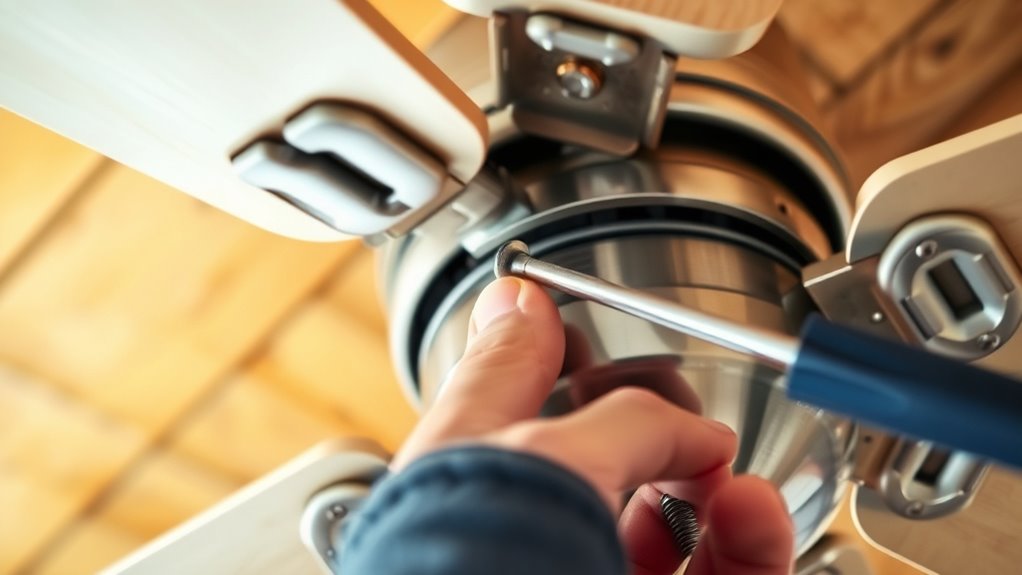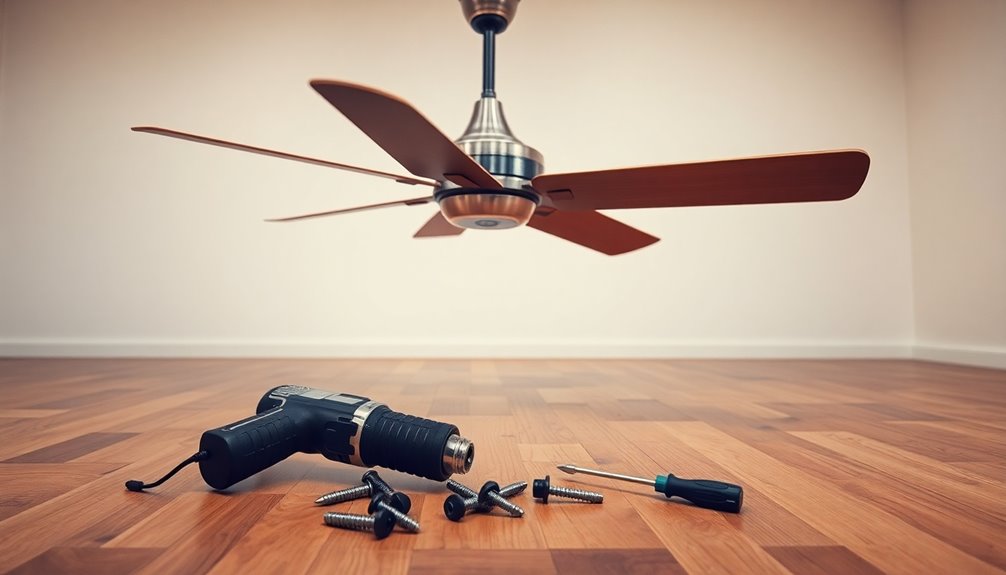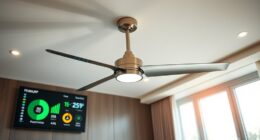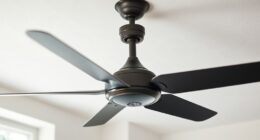To fix ceiling fan noise, start by checking for loose screws on blades, blade holders, and mounting hardware, tightening them if needed. Confirm the blades are balanced and clean to prevent wobbling and squeaking. Lubricate motor bearings with the right oil and replace any damaged blades or parts. If noise persists or involves electrical issues, it’s best to seek professional help. More tips can help you silence your fan quickly and safely.
Key Takeaways
- Identify whether noise originates from blades, motor, or mounting hardware by listening and visual inspection.
- Tighten loose screws and replace damaged blades or parts to eliminate rattling and wobbling.
- Clean dust buildup and lubricate motor bearings to reduce squeaking and grinding sounds.
- Use blade balancing kits and proper alignment to prevent wobbling and noise caused by imbalance.
- Seek professional help for electrical issues, persistent noises, or internal motor problems to ensure safety and proper repair.
Common Reasons Behind Ceiling Fan Noises
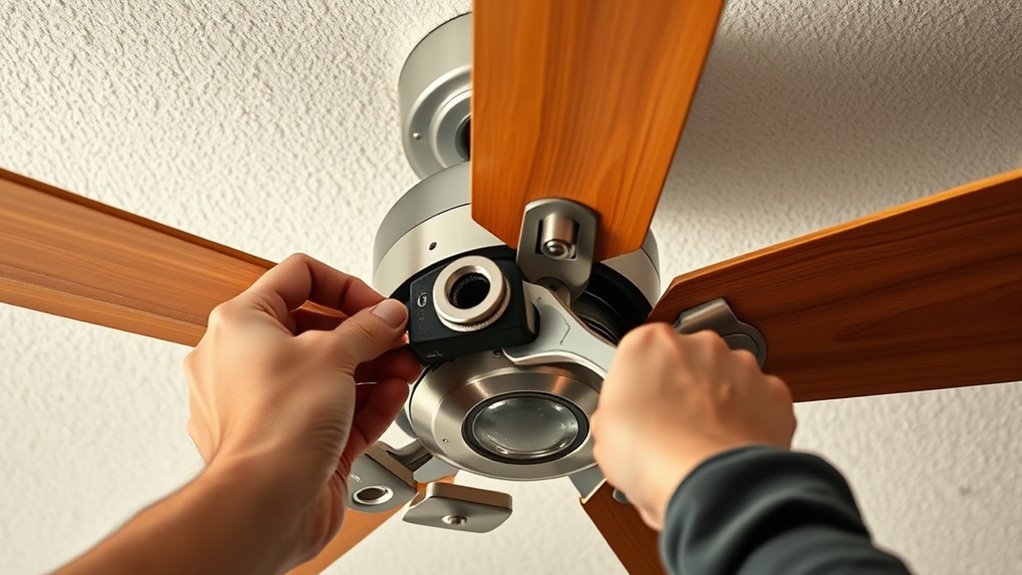
Ceiling fan noises often stem from simple issues that can be easily addressed. Loose screws on blades, blade holders, or mounting hardware can cause rattling, knocking, or clicking sounds.
Loose screws and mounting parts often cause ceiling fan rattling and clicking sounds.
Unbalanced or warped blades lead to wobbling and produce humming or buzzing noises during operation, known as fan wobble. Balancing blades can often resolve these issues and improve fan stability. Additionally, proper installation techniques are crucial to minimize vibration and noise.
Dirty or dry motor bearings create grinding or squeaking sounds when the fan runs.
Damaged blades or improper installation also contribute to noise problems.
A faulty capacitor or malfunctioning motor can generate unusual humming or buzzing sounds.
Ensuring all mounting hardware is tight and checking for damaged blades or unbalanced blades can notably reduce noise.
Addressing these common causes helps keep your ceiling fan running smoothly and quietly. Regular maintenance can prevent many of these issues from developing over time.
How to Detect the Source of Unusual Sounds

Start by listening carefully to your fan while it runs to identify where the noise is coming from. Turn it off and visually check the blades, mounting hardware, and connections for any looseness or damage. Pay attention to whether the fan wobbles or makes specific sounds like clicking or squeaking, as this can help pinpoint the problem. Examining the mounting hardware and ensuring it is secure can prevent unnecessary vibrations and noise. Additionally, checking for imbalances in the blades can help reduce noise and ensure smooth operation. Properly balancing your fan blades can also help minimize vibrations that contribute to noise and wear on the motor. Using a blade balancing kit can further assist in achieving a quieter, more stable fan. Regular maintenance and lubrication of moving parts can also prolong the lifespan and reduce unusual sounds.
Listen Carefully During Operation
Ever wonder where that strange noise is coming from when your fan is running? To troubleshoot effectively, you need to listen carefully during operation. Pay attention to the noise and try to identify whether it’s coming from the blades, motor, or mounting area. Using tools like a stethoscope or a long-handled tool can help you pinpoint the precise source of the sound. Notice if the noise occurs only at certain speeds; this can point to imbalance or motor issues. Turn the fan off to inspect blades, blade holders, and mounting hardware for looseness or damage, then listen again when you restart. Recording the type and location of the sound, such as squeaking or buzzing, helps diagnose and resolve the problem quickly. Incorporating automated insights from AI analysis can further assist in identifying patterns or recurring issues in fan performance, especially when considering projector technology for home entertainment setups. Additionally, understanding industry transformations related to AI automation can provide innovative solutions for diagnosing and fixing such mechanical issues effectively. Regular inspection and maintenance of fan components, such as lubricating moving parts, can prevent many common noise problems.
Inspect for Loose or Damaged Parts
To identify the source of unusual sounds, inspect your fan for loose or damaged parts while it’s off. Carefully examine the blades, blade brackets, and mounting hardware for loose screws or missing pieces. Automation technologies can sometimes cause vibrations or misalignments that lead to noise, so consider this as a potential factor during inspection. Gently shake the blades and other components to detect looseness or play, which may indicate worn parts or component damage. Conduct a visual inspection of the motor housing, blade brackets, and downrod for corrosion, misalignment, or cracks. Listen for rattling or knocking noises during operation that could point to loose hardware. To fix the issues, tighten any loose screws or bolts you find, especially on blade holders and mounting hardware. If you notice damaged blades or component wear, replace the affected parts to eliminate noise sources and ensure smooth operation. Additionally, vibrations caused by imbalances or misalignments can contribute to noise, so balancing the blades or realigning the fan may help reduce sound issues. Staying informed about advancements in AI can also assist in developing smarter inspection tools that detect such issues more efficiently.
Simple Fixes for Noisy Ceiling Fans
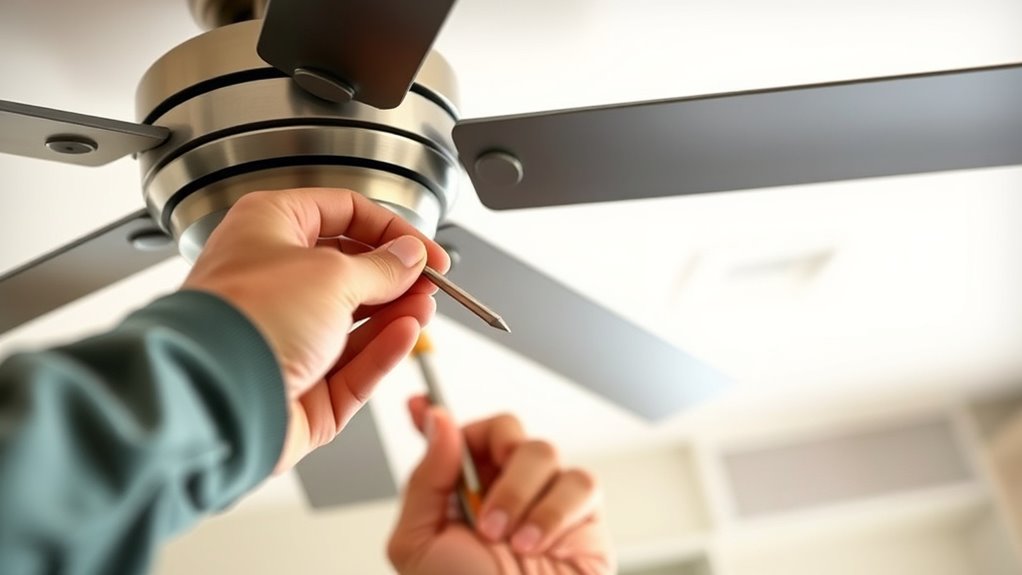
Are you tired of that annoying rattling or clicking noise from your ceiling fan? Start by checking for loose screws on blades, blade holders, and mounting hardware—tighten them to stop the noise.
Clean dust buildup from blades and motor parts to prevent imbalance and reduce squeaking noises. Regular inspection and cleaning are essential parts of maintenance that help keep your fan running smoothly. Proper maintenance also includes checking for vibration issues that can cause noise over time.
Use a blade balancing kit with adhesive weights to correct fan wobbling caused by uneven blades. Additionally, ensuring the proper lubrication of motor bearings can significantly reduce squeaking sounds and prolong the fan’s lifespan.
If you notice squeaking, lubricate motor bearings with the right oil to quiet the noise.
Inspect blades for damage or warping; replacing damaged blades improves stability.
Also, ensure mounting hardware is secure, as loose fittings can cause noise and wobble. Continuous monitoring of AI behavior in various sectors highlights the importance of proper maintenance and oversight for optimal performance and safety.
When to Seek Professional Help for Repairs

If your ceiling fan has complex electrical issues or persistent noise that won’t go away, it’s time to call in a professional. Faulty wiring, motor problems, or internal electrical repairs are best managed by experts to prevent safety hazards. Also, if your fan is under warranty, professional service helps protect your coverage and ensures proper fixes. Additionally, understanding self-watering plant pots can help you maintain healthy indoor plants, reducing the need for frequent watering and potential overwatering issues. Recognizing investment strategies can also aid in managing your finances effectively, especially when considering major home repairs or upgrades.
Complex Electrical Fixes
When dealing with electrical issues in your ceiling fan, recognizing your limits is vital. Complex electrical fixes, like replacing capacitors or rewiring connections, demand specialized tools and expertise. Attempting electrical repairs without proper knowledge can cause electrical shock, short circuits, or fires.
If you suspect capacitor malfunction, wiring issues, or motor problems, it’s best to call a professional electrician. They’ve the skills to inspect wiring, verify electrical connections, and replace damaged parts safely.
Persistent or Severe Noises
Persistent or severe noises from your ceiling fan can signal more than just annoyances—they often indicate underlying mechanical or electrical problems that require professional attention.
If you hear persistent noises like grinding or squeaking, it could be motor failure or bearing issues that need expert diagnosis.
Continuous rattling or knocking may point to loose mounting or structural damage, which can compromise safety and proper operation.
Electrical buzzing or sizzling sounds often signal wiring problems or electrical component failures, posing fire risks.
If noise levels don’t improve after basic cleaning and tightening, it’s time for professional diagnosis to prevent further damage and ensure safe fan repair.
Seek help immediately if noises are accompanied by burning smells, smoke, or if the fan stops working altogether.
Maintenance Tips for a Quieter Ceiling Fan
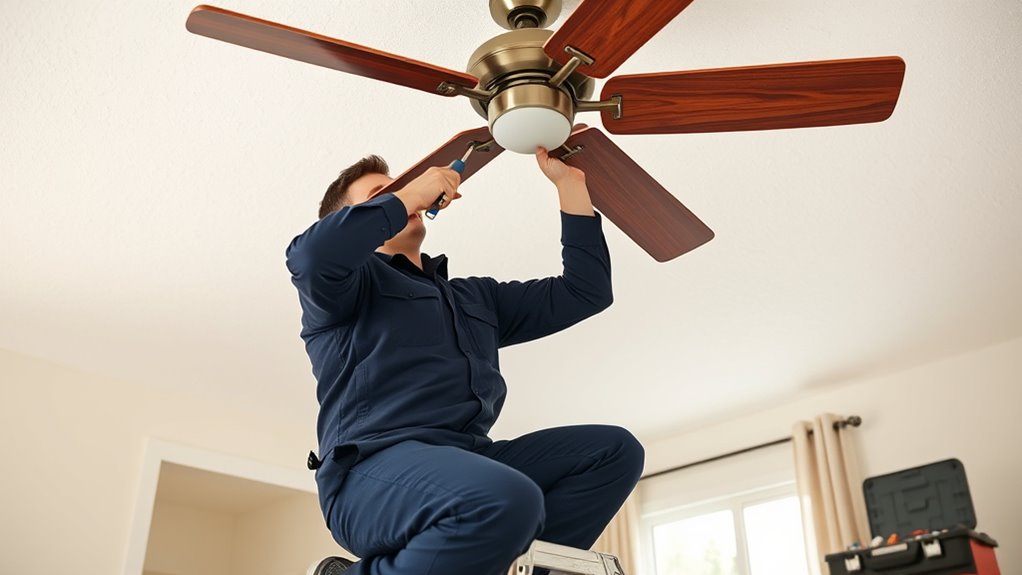
Regular maintenance is key to keeping your ceiling fan running quietly. Start by inspecting and tightening screws and mounting hardware to prevent loose components that cause rattling.
Regularly tighten screws and mounting hardware to prevent rattling and noise.
Use a balancing kit or adhesive weights to correct blade alignment and eliminate wobbling, which produces noise.
Clean fan blades and motor components regularly to remove dirt buildup, reducing imbalance and noise.
Lubricate the motor bearings annually with suitable oil to minimize friction and squeaking.
Check for and replace damaged blades or worn parts promptly, as they can compromise balance and increase noise levels.
Keeping everything in good condition ensures smoother operation and effective noise reduction.
Regular upkeep not only quiets your fan but also extends its lifespan, saving you time and money in the long run.
Troubleshooting Specific Fan Noises and How to Address Them
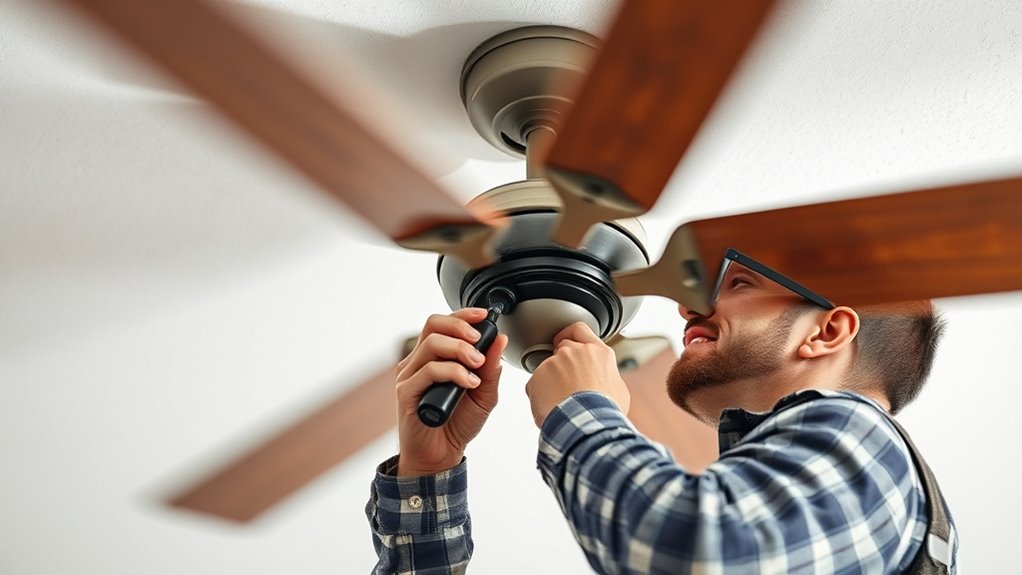
Different types of noises from your ceiling fan often point to specific issues that can be addressed with targeted solutions.
For example, clicking sounds usually come from loose screws on fan blades or blade holders; tightening these fasteners can stop the noise. Rubbing noises may indicate misaligned or improperly installed fan blades or blade holders, so verifying correct blade alignment often fixes the problem.
Buzzing or humming sounds are commonly caused by loose electrical connections or incompatible light bulbs—checking wiring and replacing bulbs helps reduce these noises. Crackling or sizzling sounds, especially if accompanied by a popcorn odor, signal electrical issues and require professional repair immediately.
Identifying the noise source is *essential* for effective fan troubleshooting and fixing your noisy ceiling fan through simple adjustments or expert assistance.
Frequently Asked Questions
How Do I Get My Ceiling Fan to Stop Making Noise?
To stop your ceiling fan from making noise, start by tightening all loose screws and bolts on the blades, motor housing, and mounting bracket.
Clean the blades and motor parts regularly to prevent dirt buildup.
Check for uneven or warped blades and balance them with adhesive weights.
Lubricate the motor bearings with the right oil, and make certain the fan is securely installed.
These steps will help quiet your fan and improve its performance.
Why Does My Ceiling Fan Make Noise When Spinning?
They say a noisy fan is a sign of trouble, and it’s true here. Your ceiling fan might make noise when spinning because of unbalanced blades, worn motor bearings, loose screws, or dust buildup.
Electrical issues could also cause humming sounds. Check for wobbling, tighten hardware, clean the blades, and inspect the motor.
Addressing these common issues can help quiet your fan and restore peace to your space.
Can You Spray WD-40 on a Noisy Ceiling Fan?
You might be tempted to spray WD-40 on your noisy ceiling fan, but it’s not the best choice. WD-40 is a penetrating oil that can temporarily quiet squeaks, but it’s not designed for fan motors.
Instead, turn off and unplug your fan, then use a lightweight machine oil or a lubricant made specifically for fans. This approach is safer and more effective for long-term noise reduction.
How to Lubricate a Noisy Ceiling Fan Motor?
To lubricate a noisy ceiling fan motor, first turn off the fan and disconnect the power.
Locate the oil ports or holes near the motor housing, then apply a few drops of lightweight, non-detergent oil like sewing machine oil or 3-in-1 oil.
Gently spin the blades by hand to distribute the oil evenly.
Regular lubrication every 1-2 years keeps the motor running smoothly and reduces noise caused by dry bearings.
Conclusion
Regularly maintaining your ceiling fan can reduce noise and prolong its lifespan. Did you know that improperly balanced fans can cause vibrations and noise, accounting for up to 30% of all ceiling fan issues? By staying on top of simple checks and fixes, you’ll enjoy a quieter, more efficient fan. Don’t hesitate to call a professional if needed—your comfort and peace of mind are worth it!
